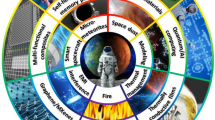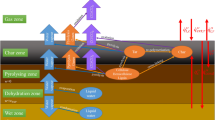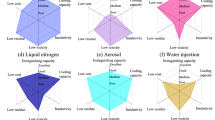Abstract
The decomposition and fire behaviors of two commonly used cables were studied by a calorimeter. The effects of the cable type, the incident heat flux, and the thermal aging on the fire characteristics were specially analyzed. Two cables showed almost the same ignition property considering the same sheath material, and the thermally thick model for both cables was identified. The changes in mass and heat release between two cables presented a significant difference. This was ascribed to the different compositions and the structures of the cables. The theoretical derivation and experimental data fitting indicated that two cables gave a different fire risk. The fire hazard was greatly promoted under higher incident heat flux because more combustible compositions decomposed contributed to heat release. The ignition time of two cables first changed slowly with the thermal aging degree and then increased sharply, with a critical aging time of 30 days. The changing trends of mass and heat release with the thermal aging degree between two cables were significantly different, which was attributed to the different compositions of cable insulation, resulting in the different thermal aging mechanisms. This work may provide an in-depth understanding of fire behaviors of commercial cables.










Similar content being viewed by others
References
Chen R, Lu S, Zhang Y, Lo S. Pyrolysis study of waste cable hose with thermogravimetry/Fourier transform infrared/mass spectrometry analysis. Energ Convers Manag. 2017;153:83–92.
He H, Zhang Q, Tu R, Zhao L, Liu J, Zhang Y. Molten thermoplastic dripping behavior induced by flame spread over wire insulation under overload currents. J Hazard Mater. 2016;320:628–34.
Courty L, Garo JP. External heating of electrical cables and auto-ignition investigation. J Hazard Mater. 2017;321:528–36. https://doi.org/10.1016/j.jhazmat.2016.09.042.
Meinier R, Sonnier R, Zavaleta P, Suard S, Ferry L. Fire behavior of halogen-free flame retardant electrical cables with the cone calorimeter. J Hazard Mater. 2018;342:306–16.
Wang C, Liu H, Zhang J, Yang S, Zhang Z, Zhao W. Thermal degradation of flame-retarded high-voltage cable sheath and insulation via TG-FTIR. J Anal Appl Pyrolysis. 2018;134:167–75.
Xie Q, Zhang H, Tong L. Experimental study on the fire protection properties of PVC sheath for old and new cables. J Hazard Mater. 2010;179(1–3):373–81.
Huang X, Nakamura Y. A review of fundamental combustion phenomena in wire fires. Fire Technol. 2019;2019:1–46.
Wang Z, Wei R, Wang X, He J, Wang J. Pyrolysis and combustion of polyvinyl chloride (PVC) sheath for new and aged cables via thermogravimetric analysis-Fourier transform infrared (TG-FTIR) and calorimeter. Materials. 2018;11(10):1997.
Mo S-J, Zhang J, Liang D, Chen H-Y. Study on pyrolysis characteristics of cross-linked polyethylene material cable. Proc Eng. 2013;52:588–92.
Hanley TL, Burford RP, Fleming RJ, Barber KW. A general review of polymeric insulation for use in HVDC cables. IEEE Electr Insul Mag. 2003;19(1):13–24.
Beneš M, Milanov N, Matuschek G, Kettrup A, Plaček V, Balek V. Thermal degradation of PVC cable insulation studied by simultaneous TG-FTIR and TG–EGA methods. J Therm Anal Calorim. 2004;78(2):621–30.
Henrist C, Rulmont A, Cloots R, Gilbert B, Bernard A, Beyer G. Toward the understanding of the thermal degradation of commercially available fire-resistant cable. Mater Lett. 2000;46(2–3):160–8.
Seguchi T, Tamura K, Ohshima T, Shimada A, Kudoh H. Degradation mechanisms of cable insulation materials during radiation–thermal ageing in radiation environment. Radiat Phys Chem. 2011;80(2):268–73.
Matala A, Hostikka S. Pyrolysis modelling of PVC cable materials. Fire Saf Sci. 2011;10:917–30.
Tewarson A, Khan MM. A new standard test method for the quantification of fire propagation behavior of electrical cables using factory mutual research corporation’s small-scale flammability apparatus. Fire Technol. 1992;28(3):215–27.
Hirschler MM. Comparison of large-and small-scale heat release tests with electrical cables. Fire Mater. 1994;18(2):61–76.
Barnes MA, Briggs PJ, Hirschler MM, Matheson AF, O’Neill TJ. A comparative study of the fire performance of halogenated and non-halogenated materials for cable applications. Part II tests on cable. Fire Mater. 1996;20(1):17–37.
Grayson S, Van Hees P, Green AM, Breulet H, Vercellotti U. Assessing the fire performance of electric cables (FIPEC). Fire Mater. 2001;25(2):49–60.
Quintiere J, Harkleroad M, Walton D. Measurement of material flame spread properties. Combust Sci Technol. 1983;32(1–4):67–89.
Hirschler MM. Survey of fire testing of electrical cables. Fire Mater. 1992;16(3):107–18.
Fernandez-Pello A, Hasegawa H, Staggs K, Lipska-Quinn A, Alvares N. A study of the fire performance of electrical cables. Fire Saf Sci. 1991;3:237–47.
Zavaleta P, Audouin L. Cable tray fire tests in a confined and mechanically ventilated facility. Fire Mater. 2018;42(1):28–43.
McGrattan KB, Lock AJ, Marsh ND, Nyden MR. Cable heat release, ignition, and spread in tray installations during fire (CHRISTIFIRE): phase 1-horizontal trays 2012.
McGrattan KB, Bareham SD. Cable heat release, ignition, and spread in tray installations during fire (CHRISTIFIRE) phase 2: vertical shafts and corridors 2013.
Huang X, Zhu H, Peng L, Zheng Z, Zeng W, Bi K, et al. Burning behavior of cable tray located on a wall with different cable arrangements. Fire Mater. 2019;43(1):64–73.
Tao H, Zhang X, Guo Z, Zeng W, Huang X, Zheng Z, et al. Combustion characteristics and heat release rate of vertical cable fire for sustainable energy system in an analogue underground compartment. Sustain Cities Soc. 2019;45:406–12. https://doi.org/10.1016/j.scs.2018.12.001.
Emanuelsson V, Simonson M, Gevert T. The effect of accelerated ageing of building wires. Fire Mater. 2007;31(5):311–26. https://doi.org/10.1002/fam.944.
Wang Z, Wang J. An experimental study on the fire characteristics of new and aged building wires using a cone calorimeter. J Therm Anal Calorim. 2019;135(6):3115–22.
Ding Y, Ezekoye OA, Zhang J, Wang C, Lu S. The effect of chemical reaction kinetic parameters on the bench-scale pyrolysis of lignocellulosic biomass. Fuel. 2018;232:147–53. https://doi.org/10.1016/j.fuel.2018.05.140.
Schartel B, Hull TR. Development of fire-retarded materials—interpretation of cone calorimeter data. Fire Mater. 2007;31(5):327–54.
Rhodes BT, Quintiere JG. Burning rate and flame heat flux for PMMA in a cone calorimeter. Fire Saf J. 1996;26(3):221–40.
Janssens M. Piloted ignition of wood: a review. Fire Mater. 1991;15(4):151–67.
Spearpoint MJ, Quintiere JG. Predicting the piloted ignition of wood in the cone calorimeter using an integral model—effect of species, grain orientation and heat flux. Fire Saf J. 2001;36(4):391–415.
Khan MM, Bill RG, Alpert RL. Screening of plenum cables using a small-scale fire test protocol. Fire Mater. 2006;30(1):65–76.
Babrauskas V, Grayson S. Heat release in fires. Berlin: Taylor & Francis; 1990.
Grayson SJ. Fire performance of electric cables-new test methods and measurement techniques. Final Report on the European Commission SMT Programme Sponsored Research Project SMT4-CT96-2059; 2000, p. 410.
Brebu M, Vasile C, Antonie SR, Chiriac M, Precup M, Yang J, et al. Study of the natural ageing of PVC insulation for electrical cables. Polym Degrad Stabil. 2000;67(2):209–21.
Quennehen P, Royaud I, Seytre G, Gain O, Rain R, Espilit T, et al. Determination of the aging mechanism of single core cables with PVC insulation. Polym Degrad Stabil. 2015;119:96–104. https://doi.org/10.1016/j.polymdegradstab.2015.05.008.
Jakubowicz I, Yarahmadi N, Gevert T. Effects of accelerated and natural ageing on plasticized polyvinyl chloride (PVC). Polym Degrad Stabil. 1999;66(3):415–21. https://doi.org/10.1016/S0141-3910(99)00094-4.
Sibulkin M, Kim JVC Jr. The dependence of flame propagation on surface heat transfer I. Downward burning. Combust Sci Technol. 1977;14(1–3):43–56.
Pagacz J, Chrzanowski M, Krucinska I, Pielichowski K. Thermal aging and accelerated weathering of PVC/MMT nanocomposites: structural and morphological studies. J Appl Polym Sci. 2015. https://doi.org/10.1002/app.42090.
Oluwoye I, Altarawneh M, Gore J, Dlugogorski BZ. Oxidation of crystalline polyethylene. Combust Flame. 2015;162(10):3681–90.
Wang Z, Wei R, Ning X, Xie T, Wang J. Thermal degradation properties of LDPE insulation for new and aged fine wires. J Therm Anal Calorim. 2019;137(2):461–71. https://doi.org/10.1007/s10973-018-7957-5.
Acknowledgements
This work was supported by the National Key R&D Program of China (No. 2018YFC0809500). The authors gratefully acknowledge this support. Zhi Wang thanks for the support from China Scholarship Council (CSC).
Author information
Authors and Affiliations
Corresponding author
Additional information
Publisher's Note
Springer Nature remains neutral with regard to jurisdictional claims in published maps and institutional affiliations.
Rights and permissions
About this article
Cite this article
Wang, Z., Wang, J. Comparative thermal decomposition characteristics and fire behaviors of commercial cables. J Therm Anal Calorim 144, 1209–1218 (2021). https://doi.org/10.1007/s10973-020-10051-z
Received:
Accepted:
Published:
Issue Date:
DOI: https://doi.org/10.1007/s10973-020-10051-z




